Bush Helicopters
By the inherent nature of bush flying, helicopters have found their way into the bush in good numbers. Sikorskies, Bells, Hillers, Eurocopters, Enstroms, Aerospatiales, Kamans, Robinsons, Schweizers, and others, have all found their way to the bush. Helicopters are used in the bush for everything from sightseeing, to surveying, to lifting logs for timber cutters. Helicopters are ideal for the bush given their vertical take-off and landing capacity (VTOL) and consequently, there has not been a development of "bush helicopters" such as there has been with airplanes. Like everything in life, there are Helicopters that are better than others at specific tasks, but there is no one—or even several—helicopter designed for the bush. Most helicopters—particularly the smaller ones, can be fitted it floats. We won't attempt to describe all the helicopters that may be found in the bush, we'll just touch upon some of the more notable ones.
Robinson R-22 and R-44
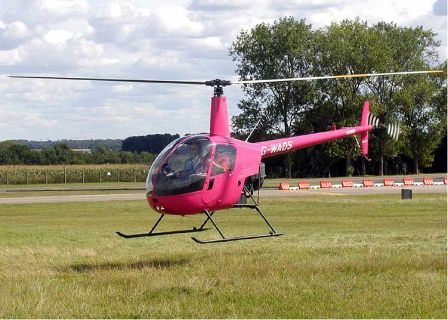
Frank Robinson did in the 1970s what many considered to be impossible. He designed a piston powered helicopter that was cheap (as far as helicopters go) to fly and maintain. His initial design was the two seat R-22 and has a 180 hp Lycoming engine. The R-44 is a four seater that features a 260 hp engine that produces 260 hp. While these aircraft are in no way a cheap as fixed wing two and four seat airplanes, they are cheaper to maintain than similar piston helicopters, most notably the Bell 47, Schweizer (Hughes) 300 Hiller and Enstrom Helicopters. The Robinsons must be overhauled once they reach 2,200 hours of flight time (it is not legal to exceed this time limit such as "on condition" airplane engines that are sometimes operated well beyond their overhaul times). The 2,200 hour overhaul is extensive and expensive—it can cost in excess of $100,000 for the R-22 and more for the R-44. After 4,400 hours of flight time the Robinsons most undergo an even more extensive (and mandatory) overhaul at which point they are considered “new.” It is possible to buy Robinsons for $30,000--$40,000 on the internet, but these helicopters will inevitably be very close to one of these mandatory overhauls. The price of used Robinsons are directly tied to their service life, more so than most any other aircraft.
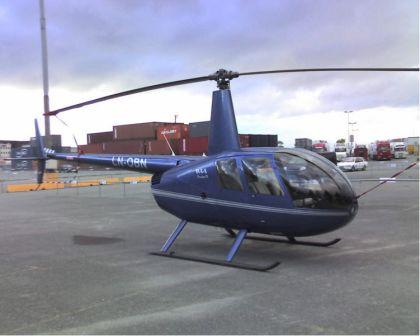
While the Robinsons are by all rights, great helicopters (Frank Robinson is considered the William Piper of the helicopter world), they are demanding to fly. An R-22 is much more difficult for the beginning helicopter pilot to master than the Bell 47 or Schweitzer and there is much criticism of the Robinson helicopters' flying characteristics. Obviously, some of this criticism comes (directly or indirectly) from competitors. In reality, while the Robinsons are more demanding than other helicopters to fly, they are not impossible to master. It is relatively safe to say that if one can fly a Robinson, all other piston helicopters are a piece of cake to fly.
Despite all the criticism of the Robinsons, they have been well received in the marketplace, and can be found all over the world. Frank Robinson revolutionized the helicopter world with these designs.
Bell 47 and Schweizer (Hughes) 300

While the Bell 47 and the Schweizer 300 are very different in appearance, they are both classical helicopter designs. The Bell was the first certified helicopter in the US and is widely known to the world as the helicopter that was featured in the opening scenes of the hit 70s television show M*A*S*H. The Bell 47s featured a bewildering array of engines from Lycomings to Franklins and some were converted to turboshafts. Bell 47s are much easier to fly than Robinsons, but they are also more expensive to maintain. Because of their widespread skids, dynamic roll-overs (see section on helicopter flying) is not as great a concern in the 47 as other helicopters. Bells 47s typically seat two for training versions and three for non-training versions. The 47J model could seat four. These helicopters are no longer manufactured by Bell.
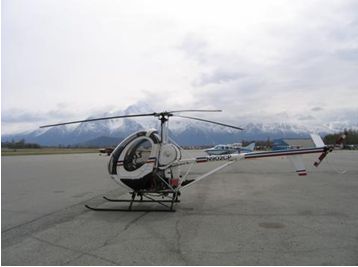
Schweizer 300
Schweizer acquired the rights to the Hughes 269 series of helicopters and currently produces them in two models. The Hughes 269 was used extensively by the United States Army to train helicopter pilots and it is a nice flying helicopter by piston helicopter standards. Like the short bodied (mostly V-tail) Beech Bonanza, the Schweizer has some minor instability in flight and will sometimes wag its tail like a Bonanza.
Enstrom
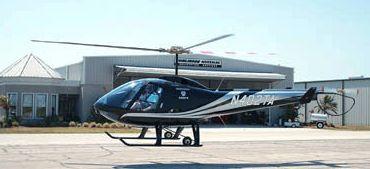
Enstroms are light predominantly piston engine helicopters though the company does offer a turboshaft version of the basic design. The piston models generally seat two people. The Enstroms are not as common as Robinsons, but can be frequently encountered nevertheless. They are popular "personal helicopters" and given the prices of all helicopters, one can appreciate why not every airport has an Enstrom sitting around.
Bell 206 Jet Ranger
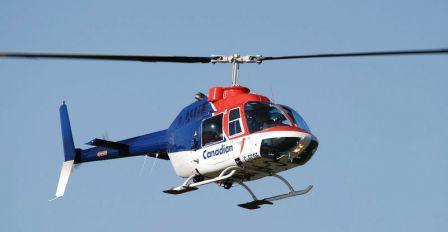
Bell 206s are everywhere, if one sees a newschopper flying over, chances are great that it is a Bell 206 Jet Ranger. The Bell 206 is powered by an Allison turboshaft engine and is the first jet engine helicopter most people encounter. These helicopters are also very frequently used for sightseeing tour operators, surveyors and others. Like the Robinsons, these helicopters can be found worldwide and many have served in various military capacities around the world. It comes in the standard model (photo above) and the Long Ranger with is a slightly lengthened version of the original. Various versions of this helicopter are still produced by Bell.
Sikorsky S-54 Sky Crane, S-61, S-62 and Boeing Chinook

These are all heavy haulers and were initially designed for the military. The Sky Crane was designed to have a detachable pod to be carried under its skeletal frame. The idea was that the pods could be loaded and unloaded regardless of where the helicopter was, in actual use this proved to be more of a novelty than actual advantage. The S-61 and 62 series are amphibious and have watertight hulls. The Chinook featured a tandem rotor design eliminating the need for a tail rotor as the tandem rotors counteracted each other's torque.

All of these helicopters have been used in a variety of roles around the world. In the bush they are often used for heavy vertical lifting such as for logging operation. There are helicopters that will lift more, non are as common as these (particularly in the bush) and most of the heavier lift helicopters are Russian from the Soviet era.
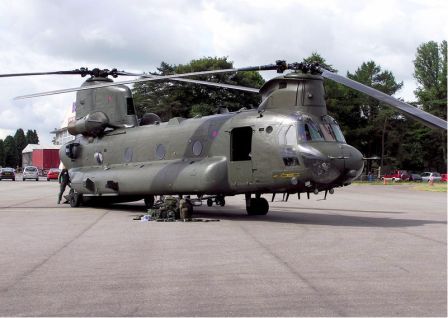
While the Sikorsky and Boeing heavy lifters are by no means abundant, one will see them in the bush occasionally. These are very expensive aircraft and are operated commercially.
Experimental Helicopters
In the discussion of bush planes on this website we have considered many experimental planes. While there are many experimental helicopters on the market, few are found in the bush. Most—not all—are very limited helicopters unsuited for flight except under ideal conditions. Some are, in the author's opinion, outright dangerous and should not be marketed to the public. Many have too small a tail rotor for windy conditions and main rotors are too small to make successful auto rotations. We won't name names, but we won't include them here either. Perhaps the time will come for homebuilt helicopters (and Canadian Home Rotors and the Hummelbird seem to be on the right track) but most of the experimental helicopters do not merit consideration as practical machines.